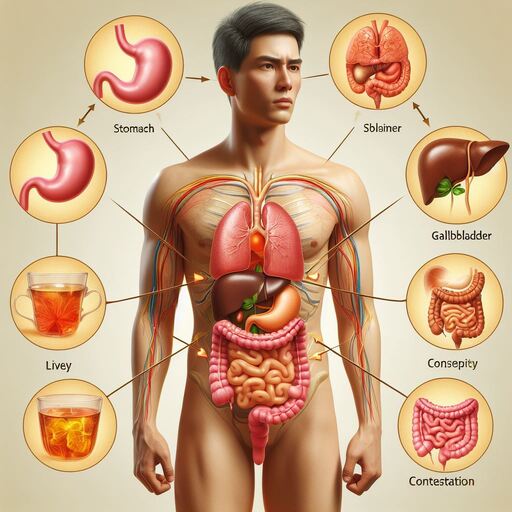Decoding Abdominal Discomfort Causes and Solutions
Abdominal discomfort is a common and often troubling symptom experienced by individuals of all ages. It can range from mild and transient to severe and persistent, impacting daily life and overall well-being. Understanding the causes behind abdominal discomfort is crucial for effective management and relief. In this article, we delve into the various factors that can contribute to abdominal pain and explore potential solutions.
Common Causes of Abdominal Discomfort
Abdominal discomfort can stem from a multitude of underlying factors, including:
- Gastrointestinal Issues: Disorders of the gastrointestinal tract are frequent culprits of abdominal pain. These may include acid reflux, gastritis, peptic ulcers, inflammatory bowel diseases (such as Crohn’s disease or ulcerative colitis), irritable bowel syndrome (IBS), constipation, or food intolerances.
- Infections: Viral, bacterial, or parasitic infections affecting the gastrointestinal system can lead to abdominal discomfort. Examples include gastroenteritis (stomach flu), food poisoning, or infections of the gallbladder or pancreas.
- Structural Abnormalities: Conditions like hernias, abdominal adhesions (scar tissue), or tumors in the abdomen can cause persistent pain or discomfort.
- Reproductive Issues: For women, conditions related to the reproductive organs such as menstrual cramps, ovarian cysts, or endometriosis can manifest as abdominal pain.
- Urinary Tract Problems: Issues affecting the kidneys, bladder, or ureters, such as urinary tract infections (UTIs) or kidney stones, can cause lower abdominal pain.
- Musculoskeletal Causes: Sometimes, pain originating from muscles or skeletal structures in the abdominal region (such as strained muscles or rib fractures) can mimic internal organ-related discomfort.
- Nervous System Disorders: Certain conditions affecting the nerves, such as neuropathies or nerve entrapments, may cause referred pain in the abdomen.
- Psychological Factors: Stress, anxiety, or depression can contribute to abdominal discomfort, often linked to conditions like functional abdominal pain syndrome or somatic symptom disorder.
Identifying the Source of Abdominal Pain
Decoding Abdominal Discomfort Causes and Solutions
Pinpointing the exact cause of abdominal discomfort requires a thorough evaluation by a healthcare provider. Diagnosis typically involves a combination of medical history, physical examination, and sometimes diagnostic tests such as blood tests, imaging studies (like ultrasound or CT scan), or endoscopic procedures (such as colonoscopy or upper endoscopy).
The nature of the pain itself can provide clues to its origin. For instance:
- Sharp, localized pain: May indicate a specific organ or structural issue, such as appendicitis or gallstones.
- Cramping or bloating: Often associated with gastrointestinal conditions like IBS or functional dyspepsia.
- Colicky pain: Typically seen with conditions like kidney stones or intestinal obstruction.
- Referred pain: Pain felt in a different location than the source, such as shoulder pain with gallbladder issues or back pain with pancreatitis.
Treatment and Management
The appropriate management of abdominal discomfort depends on its underlying cause. Treatment strategies may include:
- Medications: Over-the-counter or prescription medications can help alleviate symptoms. For example, antacids for acid reflux, antispasmodics for IBS-related pain, or antibiotics for bacterial infections.
- Dietary Changes: Adjustments in diet may be recommended based on the suspected cause of discomfort. This could involve avoiding trigger foods (e.g., spicy or fatty foods for acid reflux), increasing fiber intake for constipation, or following a low-FODMAP diet for IBS.
- Lifestyle Modifications: Incorporating stress-reduction techniques, regular exercise, and adequate hydration can positively impact abdominal symptoms, especially those influenced by psychological factors.
- Surgical Intervention: In cases of structural abnormalities like appendicitis, hernias, or certain gallbladder or intestinal conditions, surgical procedures may be necessary to correct the issue.
- Therapies: Some individuals benefit from complementary therapies such as acupuncture, biofeedback, or cognitive-behavioral therapy (CBT) to manage chronic abdominal pain, particularly when psychological factors are involved.
When to Seek Medical Attention
Decoding Abdominal Discomfort Causes and Solutions
While mild and occasional abdominal discomfort may resolve on its own or with simple interventions, certain signs and symptoms warrant prompt medical attention:
- Severe or persistent pain
- Pain accompanied by fever, vomiting, or blood in stool
- Sudden onset of pain, especially if it’s different from previous experiences
- Abdominal pain during pregnancy
- Pain following trauma or injury
These red flags may indicate serious underlying conditions that require immediate evaluation and treatment by a healthcare professional.
Decoding Abdominal Discomfort Causes and Solutions
Conclusion
Abdominal discomfort is a symptom that can arise from a spectrum of causes, ranging from benign to potentially life-threatening conditions. Proper evaluation and diagnosis are essential for effective management and relief. If you or someone you know experiences persistent or , seeking medical attention promptly is advised to identify the underlying cause and initiate appropriate treatment. By decoding the sources of abdominal discomfort and implementing targeted solutions, individuals can regain comfort and improve their quality of life.
